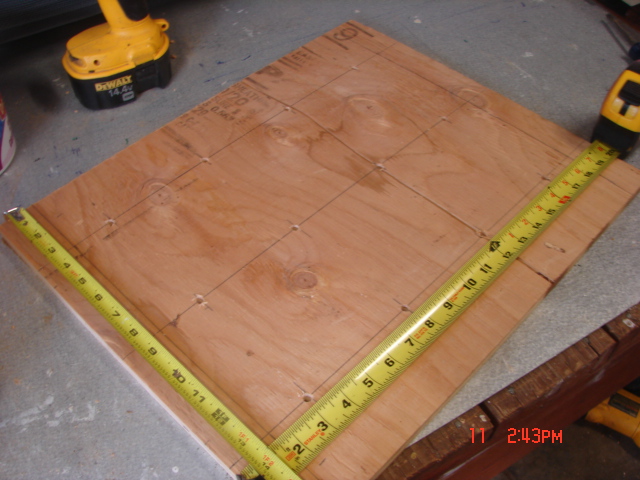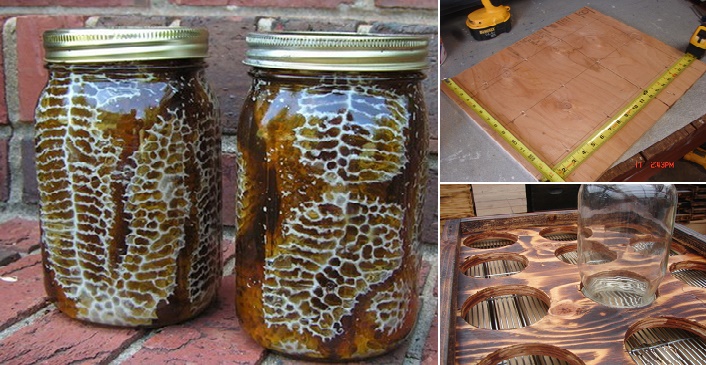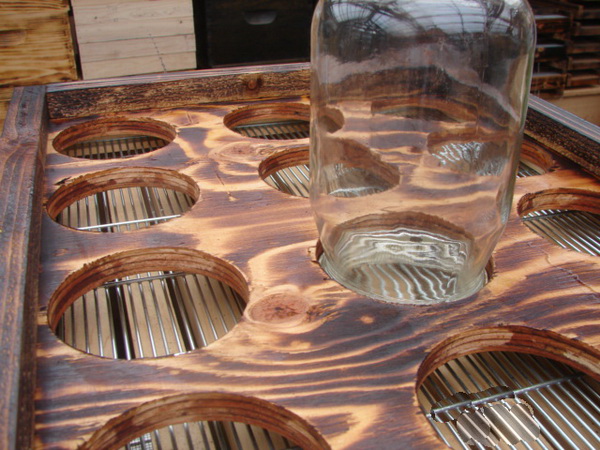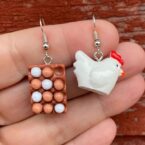Producing your own food at home is always a good idea, and this is also true when it comes to honey. As you know, in order to make honey you will need a beehive, which can’t be found on every corner. You’re in for a treat today, as you will learn how to set up your own beehive in your yard. You don’t even need to live in the suburbs for this project, as a small backyard will be sufficient. The tutorial was created by an experienced beekeeper and the ingredients you’ll need are: wood, beehive kit, plywood, jars, wood screws, wood stain and bees, of course. Follow the video for the instructions and you will be able to build your own beehive very soon. Then you can start producing organic honey, as this is the first step towards a greener way of life.
 Mark your holes and use a square to get them straight.
Mark your holes and use a square to get them straight.
 3 1/2″ hole saw makes the right sized hole for this application. (Add some shims to support the queen excluder so it won’t sag in the middle with the weight of the honey)
3 1/2″ hole saw makes the right sized hole for this application. (Add some shims to support the queen excluder so it won’t sag in the middle with the weight of the honey)
***An Absolute Beginner’s Guide to Keeping Bees in Your Yard and Garden

















Doesn’t it get too hot in those clear glass jars? Seems like the honey & waxwould melt.
That’s exactly what I was thinking, Mary.
That’s what I thought. The jars would get so hot it would melt the wax and cook the bees.
You didn’t watch the video to the end.
This is cruel to the bees. It is only for one year and if you take all the wax and honey, what will the bees live on for the winter. You will starve the bees and displace the queen.
Actually, the honey that the bees live on over winter is in the big bottom base with the main hive. The base provides ample room for the colony and its needs, and that honey is never harvested. The bees will make far more than they need, and the supers you provide are just a storage attic. Experienced bee keepers manage the hives by hefting the main boxes to ensure they are heavy, and the bees themselves do not move “up” unless the main stores are groaningly full. If you DON’T give them extra room then they’ll split, half will abscond, and the hive will be smaller and possibly weaker for the winter. The same is true of comb. They have plenty down where you cannot see it in these pictures.
Ethel, Beekeepers NEVER take all of the bees honey. A colony of bees cost between $100- $150 add $400 worth of equipment to house them, inspect them and extract SOME of their honey. It is not economical to kill off your bees every winter by taking all of their honey. The Langstroth hive is designed to stack more and more “supers” on top when the bees create more honey than the colony needs. What you usually see is a snapshot of a beehive, what you don’t get to see is the the number of supers that are changed throughout the year. These supers are a fad, they have been around for a while but not many people do it, for one, it takes the bees about 15 lbs of honey to make 1 lb of wax. We do not harvest our comb, but extract the honey from the comb with a radial extractor, it spins the honey out and we put the comb back on the hive, or put it in the freezer to keep for the following Spring. The freezer kills some pf the parasites that prey on bees. Find a local bee club and go to some meetings, it’s a great way to meet some really cool people. Beekeepers for the most part are really awesome people. Always learning from your bees, if not, you won’t have them very long.
I think it is cruel to take away their honey because that is what they live on in the winter time. I have read that if you feed them sugar water in a bucket it helps them make more honey more quickley. It is things like these temporary hives that are killing off all our bees.
Great idea…. this would be no different than harvesting in the usual way. I will be trying this myself!!!
Not much organic honey around, you have to have your bees 5 miles from anyone who uses any chemicals on their property. Not much of that anywhere east of the Mississippi. There are USDA requirements, however no enforcement for labeling. To solve this, get to know your local beekeepers and buy local. Most major grocery store brands honey is imported from China, and filtered, to remove pollen, which is honeys footprint- Apiary labs can test the pollen in honey and tell what state it comes from, pollen is good for you, removing pollen from honey makes no sense unless you are trying to hide where it came from and just turn a profit, instead of sharing 100% of the natural benefits with customers.